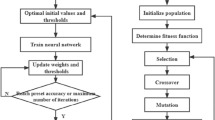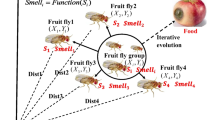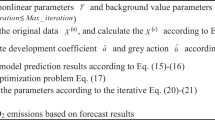Abstract
With economic development and the acceleration of urbanization, China’s energy demand has gradually increased and brought a lot of energy-related CO2 emissions. Energy-related CO2 emissions are affected by a variety of factors. Quantifying the correlation between energy-related CO2 and driving factors and constructing the driving factor system are conducive to predict the future energy-related CO2 emissions and analyze the impact of driving factors. In this paper, the improved grey relational analysis (IGRA) was proposed to screen the influencing factors of energy-related CO2 emissions considering the sample difference, and the factor analysis (FA) was used to reduce dimensionality of the influencing factors. Then, a carbon dioxide emission forecasting model based on the bacterial foraging optimization algorithm (BFO) and the least square support vector machine (LSSVM) was proposed. Empirical analysis results of Hebei show that the LSSVM optimized BFO significantly improves the accuracy of energy-related CO2 emissions forecasting, and IGRA-FA-BFOLSSVM model is significantly better than BP, PSOBP, SVM, and LSSVM models. The mean absolute percentage error (MAPE) of the proposed model is 0.374%. The forecasting results of the supplementary case show that the model has better generalization ability. In addition, education and technological progress have proven to be important drivers of energy-related CO2 emissions. Simultaneously, the research results can also offer more breakthrough points for policy makers to control carbon emissions.






Similar content being viewed by others
Abbreviations
- GDP:
-
Gross domestic product
- FAI:
-
Fixed asset investment
- LFR:
-
Local finance revenue
- TIETC:
-
Total import and export trade of customs
- SADR:
-
Savings deposit of residents
- PCDIP:
-
Per capita disposable income of the population
- PCCEP:
-
Per capita consumption expenditures of the population
- ENCOE:
-
Engle coefficient
- TOTP:
-
Total population
- RAEM:
-
Rate of employment
- AVWE:
-
Average wage of employees
- CPI:
-
Consumer price index
- NGIHE:
-
Number of general institutions of higher education
- NSHEI:
-
Number of students in higher education institutions
- EDUEX:
-
Education expenditure
- RDEX:
-
R&D expenditure
- NRDP:
-
Number of R & D personnel
- TECMT:
-
Technical market turnover
- NPAU:
-
Number of patent authorizations
References
Acheampong, A. O., & Boateng, E. B. (2019). Modelling carbon emission intensity: Application of artificial neural network. Journal of Cleaner Production, 225, 833–856. https://doi.org/10.1016/j.jclepro.2019.03.352.
Chen, W., Kong, F., Wang, B., & Li, Y. (2019). Application of grey relational analysis and extreme learning machine method for predicting silicon content of molten iron in blast furnace. Ironmaking & Steelmaking, 46, 974–979. https://doi.org/10.1080/03019233.2018.1470146.
Chiroma, H., Abdul-Kareem, S., Khan, A., Nawi, N. M., Gital, A. Y., Shuib, L., Abubakar, A. L., Rahman, M. Z., & Herawan, T. (2015). Global warming: predicting OPEC carbon dioxide emissions from petroleum consumption using neural network and hybrid cuckoo search algorithm. PLoS One, 10, e0136140. https://doi.org/10.1371/journal.pone.0136140.
Christis, M., Breemersch, K., Vercalsteren, A., & Dils, E. (2019). A detailed household carbon footprint analysis using expenditure accounts - Case of Flanders (Belgium). Journal of Cleaner Production, 228, 1167–1175. https://doi.org/10.1016/j.jclepro.2019.04.160.
Fan, J. L., Cao, Z., Zhang, X., Wang, J. D., & Zhang, M. (2019). Comparative study on the influence of final use structure on carbon emissions in the Beijing-Tianjin-Hebei region. Science of the Total Environment, 668, 271–282. https://doi.org/10.1016/j.scitotenv.2019.02.363.
Fang, D. B., Zhang, X. L., Yu, Q., Jin, T. C., & Tian, L. (2018). A novel method for carbon dioxide emission forecasting based on improved Gaussian processes regression. Journal of Cleaner Production, 173, 143–150. https://doi.org/10.1016/j.jclepro.2017.05.102.
Floričić, T. (2020). Sustainable solutions in the hospitality industry and competitiveness context of “green hotels”. Civil Engineering Journal, 6, 1104–1113. https://doi.org/10.28991/cej-2020-03091532.
Golley, J., & Meng, X. (2012). Income inequality and carbon dioxide emissions: the case of Chinese urban households. Energy Economics, 34, e1872. https://doi.org/10.1016/j.eneco.2012.07.025.
Guo, D. Y., Chen, H., & Long, R. Y. (2018). Can China fulfill its commitment to reducing carbon dioxide emissions in the Paris Agreement? Analysis based on a back-propagation neural network. Environmental Science and Pollution Research, 25, 27451–27462. https://doi.org/10.1007/s11356-018-2762-z.
Hsu, C., & Huang, C. (2011). Comparison of weighted grey relational analysis for software effort estimation. Software Quality Journal, 19, 165–200. https://doi.org/10.1007/s11219-010-9110-y.
Jalil, Z. A., Naji, H. I., & Mahmood, M. S. (2019). Developing sustainable alternatives from destroyed buildings waste for reconstruction projects. Civil Engineering Journal, 6, 60–68. https://doi.org/10.28991/cej-2020-03091453.
Li, J., & Cheng, Z. (2020). Study on total-factor carbon emission efficiency of China’s manufacturing industry when considering technology heterogeneity. Journal of Cleaner Production, 260, 121021. https://doi.org/10.1016/j.jclepro.2020.121021.
Li, C. B., Li, S. K., & Liu, Y. Q. (2016). A least squares support vector machine model optimized by moth-flame optimization algorithm for annual power load forecasting. Applied Intelligence, 45, 1166–1178. https://doi.org/10.1007/s10489-016-0810-2.
Liu, P., & Yang, H. (2019). Three-way decisions with single-valued neutrosophic decision theory rough sets based on grey relational analysis. Mathematical Problems in Engineering, 2019(6), 1–12. https://doi.org/10.1155/2019/3258018.
Mason, K., Duggan, J., & Howley, E. (2018). Forecasting energy demand, wind generation and carbon dioxide emissions in Ireland using evolutionary neural networks. Energy, 155, 705–720. https://doi.org/10.1016/j.energy.2018.04.192.
Mehdipour, V., & Memarianfard, M. (2017). Application of support vector machine and gene expression programming on tropospheric ozone prognosticating for Tehran metropolitan. Civil Engineering Journal, 3, 557–567. https://doi.org/10.28991/cej-030984.
Molthan-Hill, P., Robinson, Z. P., Hope, A., Dharmasasmita, A., & McManus, E. (2020). Reducing carbon emissions in business through responsible management education: Influence at the micro-, meso- and macro-levels. International Journal of Management Education, 18, 100328. https://doi.org/10.1016/j.ijme.2019.100328.
Mulenga, D., & Siziya, S. (2019). Indoor air pollution related respiratory Ill health, a sequel of biomass use. SciMedicine Journal, 1, 30–37. https://doi.org/10.28991/SciMedJ-2019-0101-5.
Passino, K. M. (2002). Biomimicry of bacterial foraging for distributed optimization and control. IEEE Control Systems Magazine, 22, 52–67. https://doi.org/10.1109/MCS.2002.1004010.
Roozbahani, A., Ghased, H., & Shahedany, M. H. (2020). Inter-basin water transfer planning with grey COPRAS and fuzzy COPRAS techniques: A case study in Iranian Central Plateau. Science of the Total Environment, 726, 138499. https://doi.org/10.1016/j.scitotenv.2020.138499.
Sun, W., & Liu, M. H. (2016). Prediction and analysis of the three major industries and residential consumption CO2 emissions based on least squares support vector machine in China. Journal of Cleaner Production, 122, 144–153. https://doi.org/10.1016/j.jclepro.2016.02.053.
Sun, W., & Xu, Y. F. (2016). Using a back propagation neural network based on improved particle swarm optimization to study the influential factors of carbon dioxide emissions in Hebei Province, China. Journal of Cleaner Production, 112, 1282–1291. https://doi.org/10.1016/j.jclepro.2015.04.097.
Sun, W., Wang, C. F., & Zhang, C. C. (2017). Factor analysis and forecasting of CO2 emissions in Hebei, using extreme learning machine based on particle swarm optimization. Journal of Cleaner Production, 162, 1095–1101. https://doi.org/10.1016/j.jclepro.2017.06.016.
Sutthichaimethee, J., & Kubaha, K. (2018). Forecasting energy-related carbon dioxide emissions in Thailand’s construction sector by enriching the LS-ARIMAXi-ECM model. Sustainability, 10, 3593. https://doi.org/10.3390/su10103593.
Tudor, C. (2016). Predicting the evolution of Co2 emissions in Bahrain with automated forecasting methods. Sustainability, 8(9), 923. https://doi.org/10.3390/su8090923.
Wei, S. W., Wang, T., & Li, Y. B. (2017). Influencing factors and prediction of carbon dioxide emissions using factor analysis and optimized least squares support vector machine. Environmental Engineering Research, 22, 175–185. https://doi.org/10.4491/eer.2016.125.
Xu, B., & Lin, B. (2018). Investigating the differences in CO2 emissions in the transport sector across Chinese provinces: Evidence from a quantile regression model. Journal of Cleaner Production, 175, 109–122. https://doi.org/10.1016/j.jclepro.2017.12.022.
Zhang, M., Anaba, O. A., Ma, Z., Li, M., Asunka, B. A., & Hu, W. (2020). En route to attaining a clean sustainable ecosystem: a nexus between solar energy technology, economic expansion and carbon emissions in China. Environmental Science and Pollution Research, 27, 18602–18614. https://doi.org/10.1007/s11356-020-08386-z.
Zhou, J. G., Guang, F. T., & Tang, R. P. (2018). Scenario analysis of carbon emissions of China’s power industry based on the improved particle swarm optimization-support vector machine model. Polish Journal of Environmental Studies, 27, 439–449. https://doi.org/10.15244/pjoes/74132.
Author information
Authors and Affiliations
Corresponding author
Additional information
Publisher’s note
Springer Nature remains neutral with regard to jurisdictional claims in published maps and institutional affiliations.
Rights and permissions
About this article
Cite this article
Sun, W., Zhang, J. Analysis influence factors and forecast energy-related CO2 emissions: evidence from Hebei. Environ Monit Assess 192, 665 (2020). https://doi.org/10.1007/s10661-020-08617-3
Received:
Accepted:
Published:
DOI: https://doi.org/10.1007/s10661-020-08617-3




